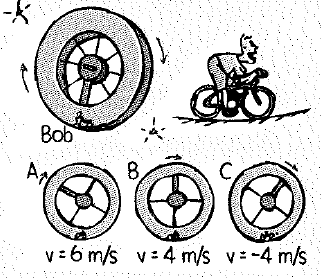
Concept explainers
Biker Bob rides his bicycle inside the rotating space station at the speeds and directions given. The tangential speed of the floor of the station is 10 m/s clockwise.

a. Rank his speeds from highest to lowest relative to the stars.
b. Rank the normal forces on Bob from largest to smallest.
(a)
The rank of the speed of the biker from highest to lowest relative to the stars.
Answer to Problem 16A
The rank of the speed of the biker from highest to lowest relative to the stars is
Explanation of Solution
Given info:
The tangential speed of the floor of the station is
Formula used:
The expression for the speed for the objects moving in same direction as follows:
Here,
Calculation:
The speed of the biker for case A as follows:
The speed of the biker for case B as follows:
The speed of the biker for case C as follows:
By comparing the values, the speed of the biker is
Hence, the rank of the speed of the biker from highest to lowest relative to the stars is
Conclusion:
Thus, the rank of the speed of the biker from highest to lowest relative to the stars is
(b)
The rank of the normal forces on Bob from largest to smallest.
Answer to Problem 16A
The rank of the normal forces on Bob from largest to smallest is
Explanation of Solution
Given info:
The tangential speed of the floor of the station is
Formula used:
The expression for the normal force on the bicycle as follows:
Here,
Calculation:
Refer part (a).
The speed of the biker for case A
The speed of the biker for case B
The speed of the biker for case C
The normal force for case A as follows:
The normal force for case B as follows:
The normal force for case C as follows:
By comparing the values, the normal force is
Conclusion:
Thus, the rank of the normal forces on Bob from largest to smallest is
Chapter 10 Solutions
Conceptual Physics: The High School Physics Program
Additional Science Textbook Solutions
Biology: Life on Earth with Physiology (11th Edition)
Anatomy & Physiology (6th Edition)
Campbell Biology (11th Edition)
Genetic Analysis: An Integrated Approach (3rd Edition)
Cosmic Perspective Fundamentals
Biology: Life on Earth (11th Edition)
- Example Two charges, one with +10 μC of charge, and another with - 7.0 μC of charge are placed in line with each other and held at a fixed distance of 0.45 m. Where can you put a 3rd charge of +5 μC, so that the net force on the 3rd charge is zero?arrow_forward* Coulomb's Law Example Three charges are positioned as seen below. Charge 1 is +2.0 μC and charge 2 is +8.0μC, and charge 3 is - 6.0MC. What is the magnitude and the direction of the force on charge 2 due to charges 1 and 3? 93 kq92 F == 2 r13 = 0.090m 91 r12 = 0.12m 92 Coulomb's Constant: k = 8.99x10+9 Nm²/C² ✓arrow_forwardMake sure to draw a Free Body Diagram as wellarrow_forward
 College PhysicsPhysicsISBN:9781305952300Author:Raymond A. Serway, Chris VuillePublisher:Cengage Learning
College PhysicsPhysicsISBN:9781305952300Author:Raymond A. Serway, Chris VuillePublisher:Cengage Learning University Physics (14th Edition)PhysicsISBN:9780133969290Author:Hugh D. Young, Roger A. FreedmanPublisher:PEARSON
University Physics (14th Edition)PhysicsISBN:9780133969290Author:Hugh D. Young, Roger A. FreedmanPublisher:PEARSON Introduction To Quantum MechanicsPhysicsISBN:9781107189638Author:Griffiths, David J., Schroeter, Darrell F.Publisher:Cambridge University Press
Introduction To Quantum MechanicsPhysicsISBN:9781107189638Author:Griffiths, David J., Schroeter, Darrell F.Publisher:Cambridge University Press Physics for Scientists and EngineersPhysicsISBN:9781337553278Author:Raymond A. Serway, John W. JewettPublisher:Cengage Learning
Physics for Scientists and EngineersPhysicsISBN:9781337553278Author:Raymond A. Serway, John W. JewettPublisher:Cengage Learning Lecture- Tutorials for Introductory AstronomyPhysicsISBN:9780321820464Author:Edward E. Prather, Tim P. Slater, Jeff P. Adams, Gina BrissendenPublisher:Addison-Wesley
Lecture- Tutorials for Introductory AstronomyPhysicsISBN:9780321820464Author:Edward E. Prather, Tim P. Slater, Jeff P. Adams, Gina BrissendenPublisher:Addison-Wesley College Physics: A Strategic Approach (4th Editio...PhysicsISBN:9780134609034Author:Randall D. Knight (Professor Emeritus), Brian Jones, Stuart FieldPublisher:PEARSON
College Physics: A Strategic Approach (4th Editio...PhysicsISBN:9780134609034Author:Randall D. Knight (Professor Emeritus), Brian Jones, Stuart FieldPublisher:PEARSON





